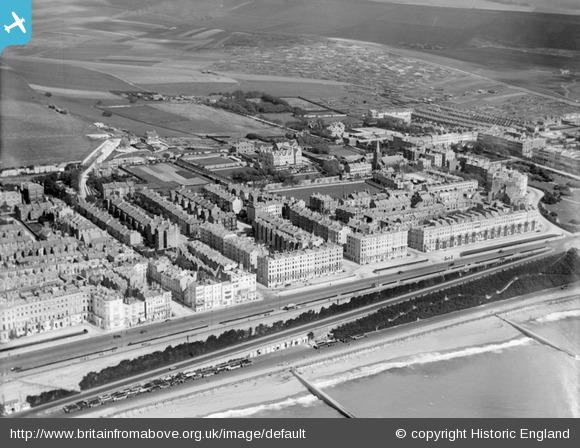Building Green has a passion for Madeira Drive – aka ‘Maddy’ – the seafront along East Brighton.
Home to Victorian wonder Madeira Terrace and the Volks Railway, major public events and a great beach, it has been home to a large number of historic events and UK and world ‘firsts’. It’s also the greenest part of the seafront in Brighton & Hove, home to rare ‘vegetated shingle’ habitat and the longest, oldest green wall in the UK.
For that reason we think it’s worth special attention, so this page provides a walk through time, from the founding of modern Brighton to the present day.

Skip to the end for recent news of work to restore this unique and valuable natural heritage, or keep reading for full history!
‘Maddy’ – A miracle mile of Victorian and modern invention
Georgian Brighton
It’s the early 1700s and the fishing town of Brighthelmstone has been declining for years. Its fishing industry was dwindling, the population was shrinking and becoming poorer thanks partly to the war with France and Holland. Storms and floods threatened to undermine the cliff on which the upper town was built.
The first act to turn the town’s fortunes around was in 1720, in the unlikely form of groynes. These timber arms, reaching out into the sea, were funded initially from public purse and later from taxes on coal landings. They captured sand and shingle from the current sweeping Eastwards, creating a protective shield between land and sea and beginning the growth of the beaches we see today.
The second major boost came from the growing interest in sea bathing, which provided the impetus for the development of a new resort.
Sea bathing had been popular informally for some time in Brighton, thanks to its relatively sheltered location in a bay, and the warm, shallow water – especially in autumn, and compared to other resorts such as Scarborough.
Around 1750, doctors like Dr Wittie and Dr Russell became interested in the health properties of salt water. Russell moved his practice here to the site of the Royal Albion Hotel – where he became such an influence on the popularity of visiting the seaside that the blue plaque simply reads ‘If you seek his monument, look around.’
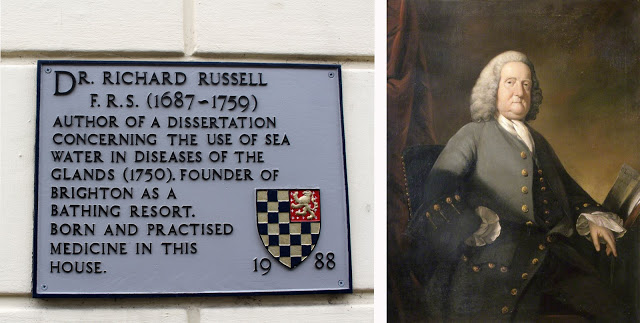
Thanks to these doctors, an increasing number of influential wealthy families, and easy access to London and France, the town began to change in character.
Bathing machines were introduced to facilitate entry to the sea and protect people’s modesty. Bathers were helped by ‘Dippers’ such as Martha Gunn, a favourite of the Prince of Wales, whose interest further boosted visitor numbers.
The Prince of Wales, later Prince Regent, visited Russell’s uncle in 1783, and this began a long association with the royal family which further accelerated Brighthemlstone’s tranformation to modern Brighton.
Regency era
In 1823 work started on the Kemp Town estate – the new development East of the Royal Pavillion by Charles Busby and Amon Henry Wilds, constructed by Thomas Cubitt, and financed by Thomas Read Kemp. This new development was the major driving force in the investment along East Brighton seafront, as a means of connecting this posh residential outpost to the town.
In the same year, the first Pier was built. It was suspended with huge chains and known as the Royal Suspension Chain Pier. People caught ferries from the end to cross the channel. They liked the feeling of walking to the end and being above the sea.

Brighton’s Chain Pier undoubtedly added impetus to the argument for a rail link to London. The pier was used primarily as a landing stage for a steam packet service to France. With the advent of the London to Brighton Railway, it would create a key route from London to Paris.
Prince Albert and Queen Victoria visit the Chain Pier in disguise, are recognised by local urchins, and have to make a run for it.
In 1827, the chalk cliffs of East Brighton were covered with a special limestone cement to stop them eroding. This was to protect the east cliff where the new buildings of Kemp Town were being established.
A great sea-wall stretching along the face of the East Cliff from Old Steine to Kemp Town was constructed in 1830-8 by William Lambert at a cost of £100,000.
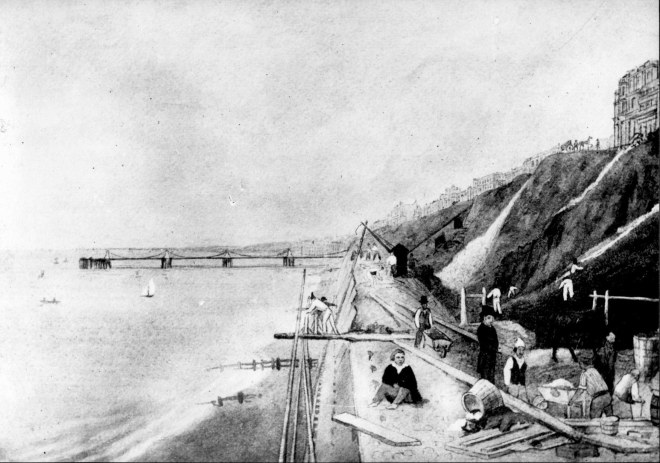
Building the Madeira Terrace Wall c1827
Constable visited with his wife Maria to improve her health. He painted the view East from Brighton in the mid-1820s – the Chain Pier and the wild plants at the bottom of the cliff are visible along with the rather anarchic beach scene.
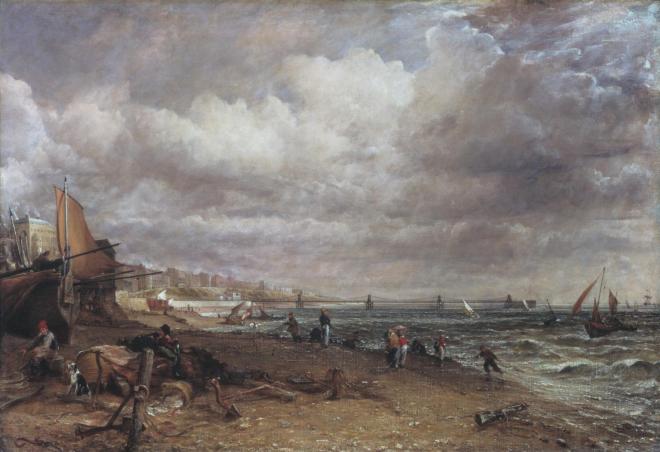
Mid-late Victorian era
In 1870 there was enough new beach to create a road at the bottom of the East Cliff. Called Madeira Road, it was protected by a new sea wall built from one of the old London bridges.
Why Madeira? The island was occupied by the British until 1814, and Madeira wine was popular with the Victorian ladies, so obviously it was in the vernacular. Our hypothesis for why this name was chosen is the link with the idea of a luxuriant garden. This book talks William Robert Wills Wilde – an Irish surgeon and father of Oscar, who visited from the 1830s and brought back stories about Madeira’s gardens, and especially its vines and a ‘hothouse in the open air’. These tales helped popularise Madeira with Victorian travellers in the 19th Century. It became known as the garden isle…and as a health spa location for the wealthy, as was Kemp Town.
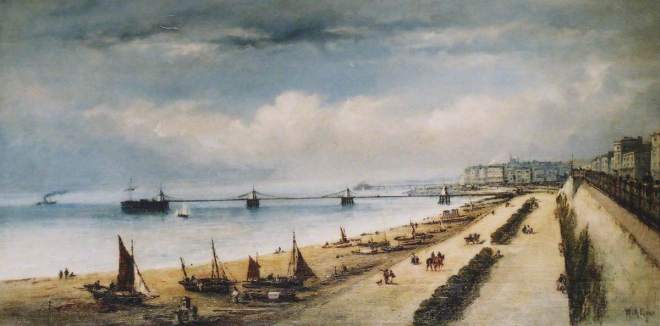
William Arthur Earp painted this view looking west towards the Chain Pier, with the railway laid out. Japanese spindle trees look around 12 feet tall here. Late 1870s? Lawns were laid out in 1884 and are not visible here. Railway established 1883
Madeira Drive Green Wall
Around this time the Victorians planted plants along the East Cliff. A woodcut print from in the Fishing Museum in Brighton, dated 1872, shows evenly spaced plants established at the bottom of the cliff. These are approximately the spacings of the plants that still exist more than 140 years later. The main plants are from Japan, and called Japanese spindle – Euonymus japonicus. They have pink and orange berries in winter.
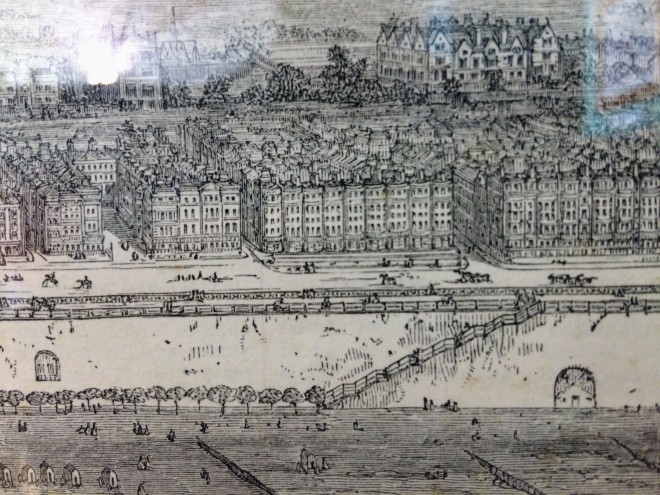
Woodcut print from London Illustrated News, 17 August 1872, from the Brighton Fishing Museum collection 1994. Showing the steps at Paston Place, a building that looks to be in the location of the Volks train workshop, and planting evenly spaced along the bottom of the cliff.
The photograph below from the James Gray collection verifies this date.

A later photograph, probably about 1872/1873. By now, the Aquarium had been built, on the site of the esplanade, and the few hesitant steps towards the construction of Madeira Drive had commenced. Note the long line of sapling trees and the ladies’ bathing machines.
Both are, of course, recent copies of old stereoscopic photographs.
Image Reference: JG_05_016.tif
Date: 1872-1873
Image Details: Copy
Size of Original: 188×101
Place: Brighton
Additional Information: ©Philippe Garner
Here, perhaps, was the Victorian vision of creating a ‘hothouse in the open air’ in the style of the Madeira terraced gardens. Photographs from c1880 show that in places, the green wall has already grown up to the top of the East cliff.

1880-1883, looking east towards the Chain Pier and Kemp Town. From the James Gray collection
Madeira Drive green wall is almost certainly the biggest, oldest and longest ‘green wall’ in the UK, and possibly Europe. There was also a green wall further West in Hove around this time.
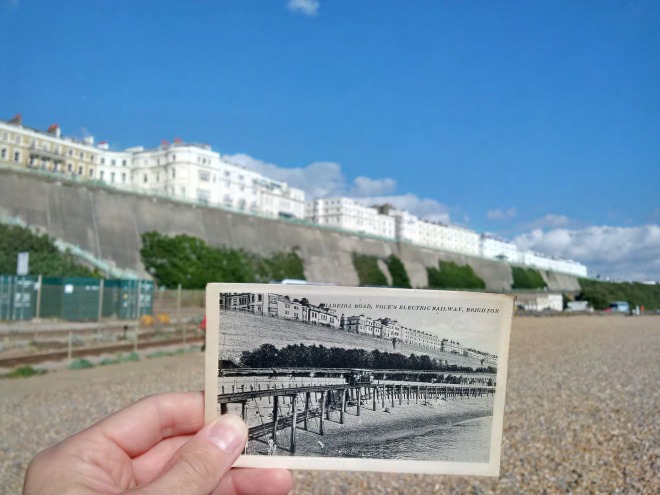
Approximately 100 years separates these photos, showing Madeira Drive, the Volks railway, Kemp Town and the Madeira Drive green wall. This is the section of wall currently managed by Building Green.
The Madeira Drive green wall originally stretched for 1.2km (fittingly, this is roughly a ‘nautical mile’!) from Duke’s Mound in the east, to the aquarium arches in the west. The plants grew up the cliff at a rate of up to 60cm a year, and some row reach 18 metres tall.

The fruits of Japanese Spindle add a splash of colour to the Brighton seafront in winte
Brighton Aquarium
Timed with the opening of Madeira Road, and likely alongside the new planting, was the grand opening of the Brighton Aquarium in 1872. Conceived by Eugenius Birch, architect of the West Pier, the aquarium was initially extremely popular. A conservatory, reading room, and roller-skating rink were added to the roof terrace. Bath stone, green marble and red Edinburgh granite featured, with a 110,000 gallon tank.
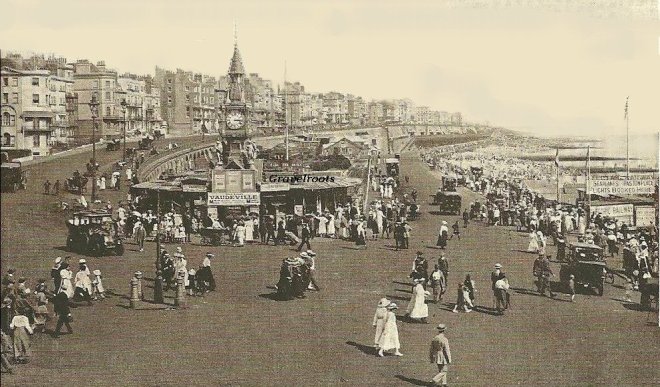
Later the aquarium hit hard times and closed in 1927, to be restored and modernised. The relaunch in 1929 was by the Duke of York, and included the extended sun terrace to meet the Madeira Terraces to the East. The Dolphinarium opened in 1968 and, though it’s hard to believe, dolphins remained a feature until 1990. It is arguably, despite the temporary closure, the oldest operating aquarium in the world.
The print below shows an early design by architect John Johnson, for improvements on Madeira Road. Johnson was the designer of the Brighton clock tower. Published in The Builder, May 5, 1883, the ‘improvements’ show features that are still in place, including the green wall.
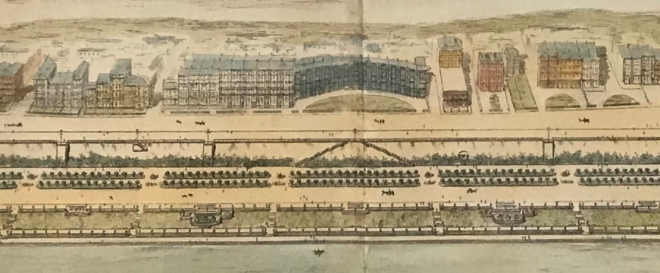
Volks railway
Although the lawns and bandstands were established, one feature missing from John Johnson’s design vision was to become the centrepiece of the new seafront. In 1883, Brightonian Magnus Volk opened the ‘Volks Electric railway‘, the oldest such railway in the world, which ran initially as far as Paston Place.
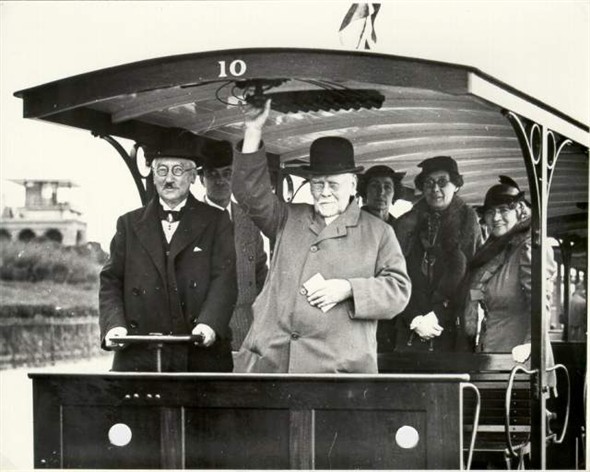
Magnus Volk riding the Volks Railway, 1933
Magnus Volk was an amazing inventor. Brighton was the first town to have electric lights thanks to him. He designed an electric car which was the first car built in England to be sold to people in Europe. He put in the first telephones into the town, and designed a fire alarm for the local fire service. He even had a patent for a device to transport a person from their bed to the street without standing up – very Wallace and Grommit!
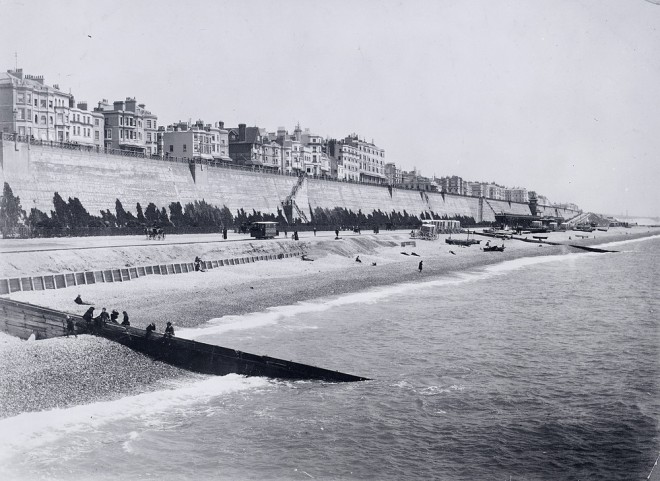 Bathing machines on the beach, Volks Railway, and Shelter Hall. c1890. Royal Pavilion & Museums, Brighton & Hove
Bathing machines on the beach, Volks Railway, and Shelter Hall. c1890. Royal Pavilion & Museums, Brighton & Hove
Volk also started work constructing The Pioneer in 1894 – otherwise known as the Daddy Long Legs – a train that ran on stilts through the sea. Launched in 1896, there were two floors including a salon with ferns, and it could fit 160 passengers. The Pioneer was probably the earliest overhead line powered rail system in the world.
A huge storm damaged the railway only one week after it opened and destroyed the Chain Pier. But the car was rebuilt with longer legs in 1897. By law, The Pioneer had to be helmed by a sea Captain. The 35 minute journey was 2 1/2d each way. The line closed in 1900. The ‘Pioneer’ was left to rot at Ovingdean pier until 1910, with the remainder sold for scrap.
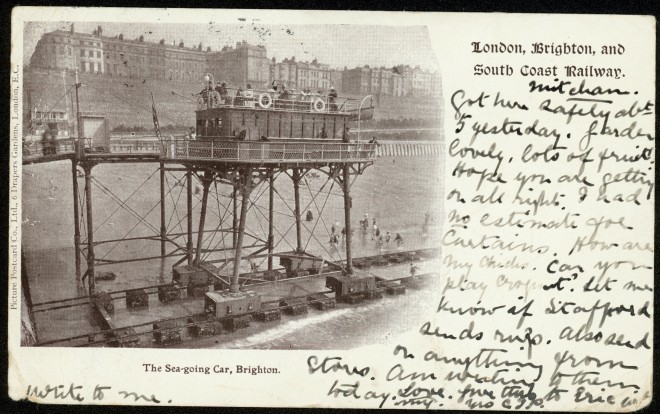
All scientists know that sea water and electricity is a dangerous combination, yet Volk still built an electric powered railway that ran through the sea
After the war the railway carried a staggering 1 million people a year.
Madeira Terrace
In 1890, to protect people from the rain and the sun, the Victorians built a covered walk called Madeira Terrace.
“…each bay of the entirely cast-iron arcade has an identical elevation: round arches carried on single columns of a fanciful marine order; scalloped-arch intrados; spandrels formed by concentric rings of quatrefoils, forming a pierced sun screen; keystone cast to resemble either a female or a bearded male deity, perhaps Venus and Neptune.” (From English Heritage listing)
Madeira Terrace is very rare being the only known, land-based, monumentally-scaled, iron promenade in England, and possibly worldwide. It was constructed in three phases, concluding in 1897.
This became a famous draw to Brighton ‘for health and pleasure all the year round’, and was connected to a shelter hall for tea and dancing. A lift went to the top of the cliff. The hall and lift are still working as part of the Concorde 2.

Rail poster to promote the ‘Famous Sheltered Walk, Madeira Drive’
The Terrace – designed by Brighton Borough Surveyor Phillip Cawston Lockwood – was deliberately built with a gap to allow the Japanese spindle plants (green wall) to continue climbing up the cliff behind. Benches were installed for promenading public to rest on – and the local paper at the time feared small children would roll all the way down the cliff through the gap, so grills had to be installed!
The Terrace has recently been upgraded to Grade II* in recognition of its uniqueness nationally and probably globally.
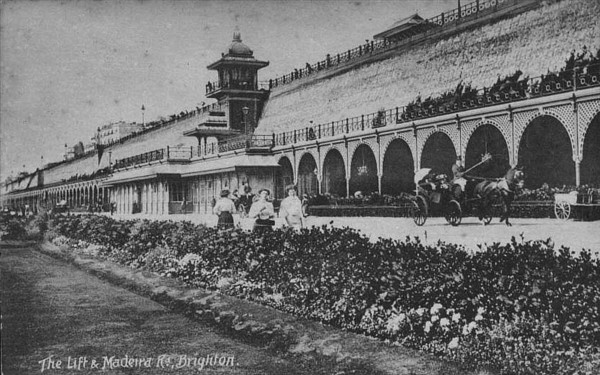
Madeira Terrace, lawns and Shelter Hall
The planting was maintained through the years, as Brighton grew around it and seafront developments came and went.
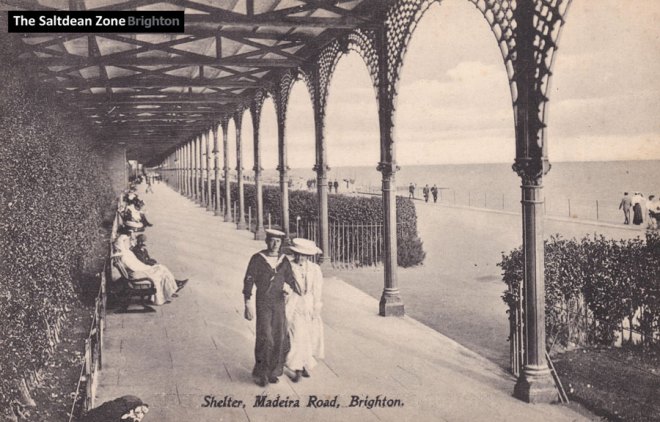
Hello Sailor! Promenading the ‘famous Madeira Terrace’
This stretch of seafront has seen bathing huts on wheels for people to change in; shows and funfairs for children – notably at Peter Pan’s playground; carts pulled by goats to ride in; boating lakes and gardens.
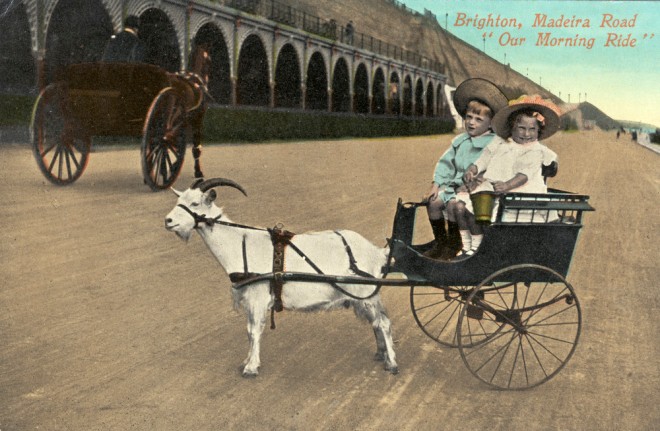
Goat cart rides on Madeira Drive! Royal Pavilion & Museums, Brighton & Hove
In 1891 the Palace Pier construction begins, designed by R St George Moore. A funding crisis caused a halt in construction, which was completed in 1901.
20th Century
1905 saw the first ‘Motor Race Week’, for which Madeira Road was tarmac’d.
During this first event 3 world records were broken; 2 by French motorcyclist Henri Cissac, who set a new record for the flying kilometre with a time of 26 seconds and a top speed of 86mph and also for a standing mile which he lowered to 53.2 seconds. The other record was set by Harry Rignold who lowered the flying mile record from 64 seconds to 46.2 seconds.

Brighton speed trials in 1905, the first ever year. Madeira Terraces provided a great viewing platform for public events.
In 1909 Madeira Road was renamed Madeira Drive. The Speed Trials were threatened in 1935 when there was a proposal to put a roof over Madeira Drive and turn it into a covered car park for 3000 cars. Luckily these plans didn’t materialise and the event was allowed to continue up until the war.
In its 90 year history the event saw a number of famous names take part, including Sir Malcolm Campbell, John Cobb, Stirling Moss, Mike Hawthorn, Ken Tyrell, John Cooper, Derek Bell, Sydney Allard and George Brown on his supercharged Vincent.
A ‘sun terrace’ was added above the shops at the west end of Madeira Drive in the 1920s, previously the entrance to the Chain Pier.

St Mary’s Hall and Kemptown 1926 showing the planting on Madeira Drive and Duke’s Mound. Pre-Carlton Hill and Whitehawk.
In 1922 a great Brighton institution began…the outdoor party! The Brighton Carnival ran through to the war, and then from the 60s to 1991, and sporadiacally in the last decade. Madeira Drive has for many years been the starting location for the LBGT Community Parade, which kicks off the UK’s biggest Pride festival.

Brighton carnival in front of Madeira Drive green wall. Royal Pavilion & Museums, Brighton & Hove
Later, from 1930, there was a big open air swimming pool with diving boards at Black Rock, where the marina is now. This nice image from ‘East Brighton Bygones’.

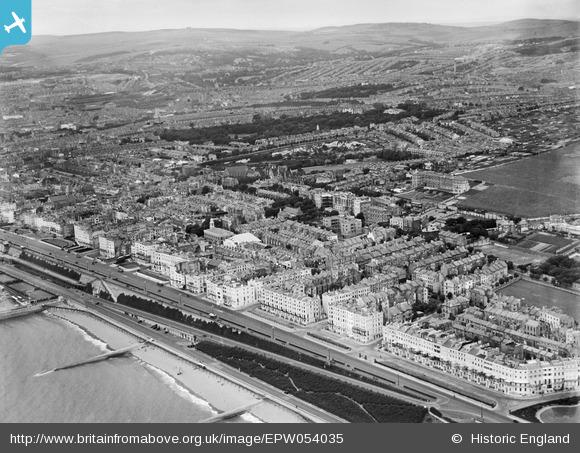
Madeira Drive green wall and Duke’s Mound from the air, 1935
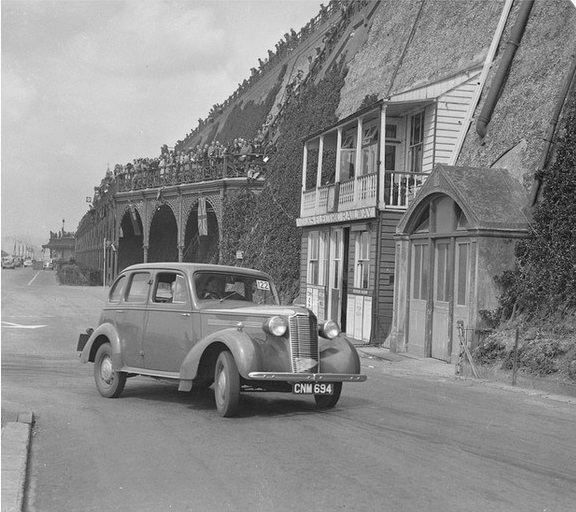
Vauxhall 14-6 of GL Boughton competing in the RAC Rally, Madeira Drive, Brighton, 1939. Photo by Bill Brunell. Really clearly shows the Volks Electric Railway workshop and the plants established on the cliff face.
The war saw much of the seafront closed off behind barbed wire.
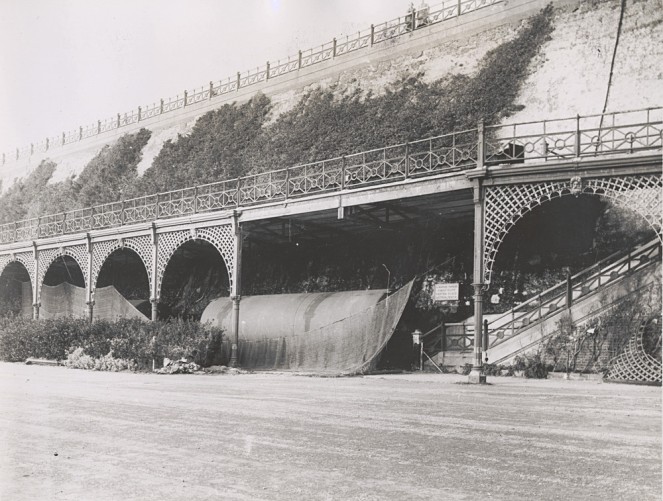
Camoflage nets in use at Paston Place, 1944. Royal Pavilion & Museums, Brighton & Hove
Further East, planting and ‘promenade’ continued to Black Rock when the formerly private estate in front of Sussex Square was opened up in 1952.
The Imperial Rifle Club had a home on the upper Madeira Terrace in the 1950s, and a shooting gallery is still in use in a different location near the Brighton Pier today.

The 1960s Brighton seafront was well known for the running battles between Mods and Rockers – often along Madeira Drive east of the pier. May bank holiday 1964 was the ‘Battle of Brighton’, with police herding people to the beach, and fighting on the Madeira Drive sun terrace and the beach.
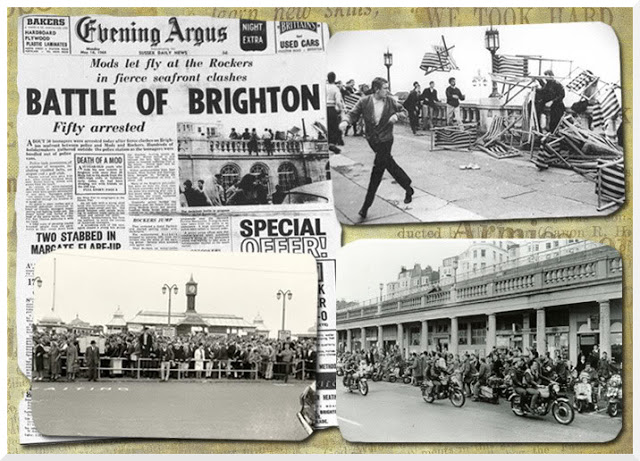
Construction of Brighton Marina commenced in 1971 and was officially opened by Queen Elizabeth II on 31 May 1979.

A notable event in the 80s was the beaching of ‘Athena B’, which was a major tourist attraction for a month until it was towed to a scrapyard in Rainham. It’s anchor remains on the promenade.

The green wall was well maintained through the 1980s, as this photograph clearly shows.

1985 view of the Madeira Terraces and trunks of spindle plants in perfectly maintained condition, and the hedge and railings still intact on the Terrace edge. Looking west towards the Shelter hall. Photo by Paul Norman
21st Century
In 2010 Brighton held its first Marathon, which finishes near a statue of local boy Steve Ovett on Madeira Drive.
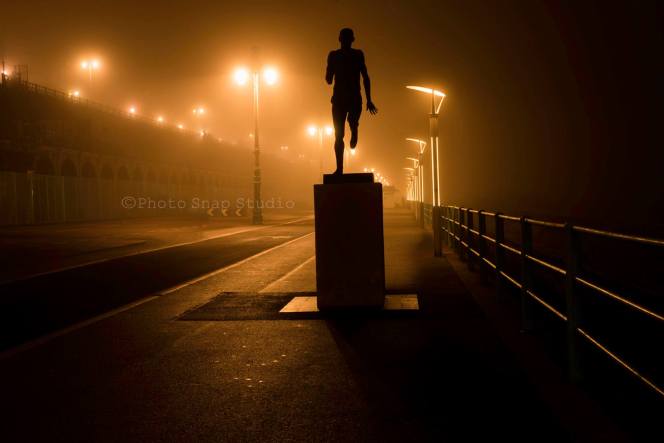
Recent developments on Madeira Drive have continued the tradition of providing fun and enjoyment for visitors, and include Yellowave Beach Sports venue, Jungle Rumble Adventure Golf, Sea Lanes pop up, and the Brighton Zip which replaced the Brighton Eye in 2016.
An open air swimming pool now has planning permission, and the Volks Railway has been enhanced with new workshops, station and impressive visitor centre.
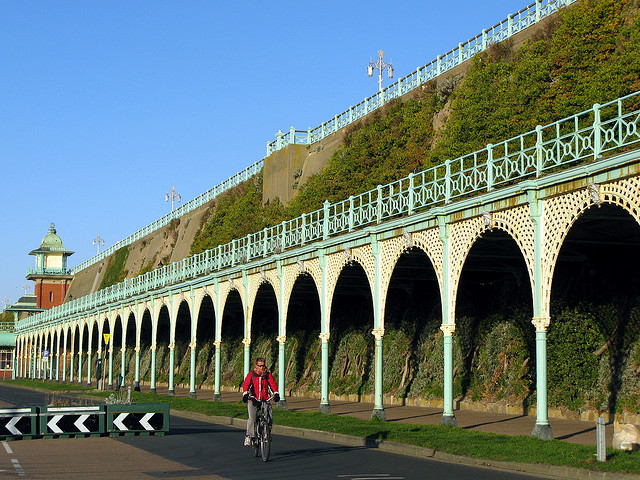
Madeira terraces before closure in 2015 – ‘The famous sheltered walk’ – with the green wall clearly visible behind. Railings and hedges to the southern edge of the terrace have been lost by this time, however many other plants have colonised the green wall.
Brighton & Hove Building Green has been working with the Council and other partners including Portslade Green Gym to restore the green wall at Duke’s Mound. The vision is to restore it to its former extent, and recently great strides have been taken with the rescue and replanting of some old Japanese Spindle trees from above the Concorde 2.
Building Green welcome the statement from Leader Warren Morgan that …
“Importantly, we are looking for ways to preserve the unique and historic Green Wall which predates the Terraces themselves, building around it just as the Terraces were, allowing the Green Wall to breathe and grow.”
‘Green Gym’ work parties take place at the green wall about twice a year, volunteers always welcome.

Councillor Gill Mitchell greets Dave Marshall from Portslade Green Gym at Madeira Drive green wall. Dave has now passed away, but was a wonderful man who helped Building Green establish the first volunteer days, a partnership that remains strong.
Volunteer wildlife recorders for Building Green have confirmed that the green wall contains over 100 different kinds of flowering plant. It’s so important, that it has been recognised as a ‘Local Wildlife Site‘ in the city plan, a nature reserve for wildlife and people to enjoy. It is the first green wall in the UK to be recognised in this way.
The Madeira Drive green wall has even featured in an international conference.
Unfortunately, Madeira Terraces have fallen into disrepair and become a danger to the public. The Council were forced to close them in 2015, pending future restoration and the much needed regeneration of East Brighton seafront.
Building Green founder James Farrell tells the story in this video from Thames Media.
In 2016, the Council announced the ‘Lockwood project‘ – the repair and restoration of Madeira Terraces alongside the continued regeneration of East Brighton seafront.
The future
In July 2017, Brighton & Hove City Council launched a successful crowdfunding appeal for the restoration of Madeira Terraces. Further bids for funding from Heritage Lottery Fund and elsewhere are underway.
In 2019 the Council set up a stakeholder advisory panel to collaborate on the design and delivery of the Terrace restoration and regeneration of Madeira Drive. Building Green represents the Environment sector on the panel.

The Lockwood Project – architect visualisation of the future seafront on Madeira Drive
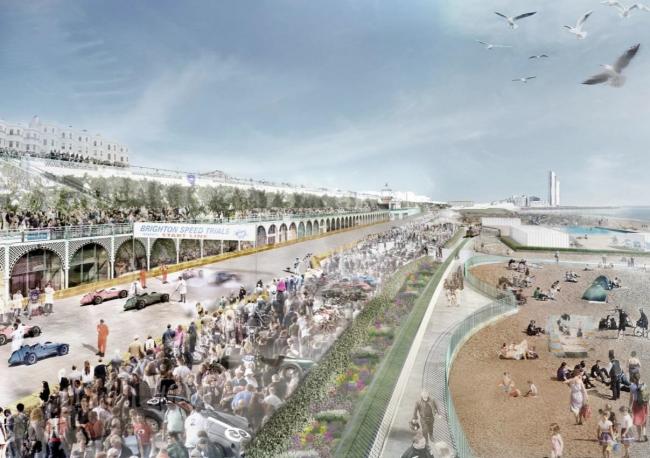
The £24 million ‘Lockwood Project’ to restore East Brighton seafront
2022 Planning application
In August 2022 the planning application was submitted for the restoration of the first quarter of the Terraces, and protection and enhancement of the green wall and associated landscaping.
Work is expected to start late 2023.
References
Volk, Conrad (1971), Magnus Volk of Brighton, Phillmore
Volks Electric Railway Assocation
Carder, T (1990), The Encyclopaedia of Brighton, East Sussex County Libraries
Sue Berry. ‘Myth and reality in the representation of resorts. BRIGHTON AND THE EMERGENCE OF THE ‘PRINCE AND FISHING VILLAGE’ MYTH 1770–1824. SUSSEX ARCHAEOLOGICAL COLLECTIONS 140 (2002), 97–112
https://www.thekeep.info/philip-c-lockwood-1821-1908-brightons-borough-surveyor/
http://www.sueberryhistorian.co.uk/2017/11/sea-bathing-in-brighton.html
https://en.wikipedia.org/wiki/Dean_Mahomed
https://en.wikipedia.org/wiki/Martha_Gunn
https://www.tcv.org.uk/media_hub/connecting-with-nature-to-support-mental-health/
History of Brighthelmston or, Brighton as I View it and other Knew, John Ackerson Erredge. Transcribed from the 1862 E. Lewis edition by David Price https://www.gutenberg.org/files/50551/50551-h/50551-h.htm

